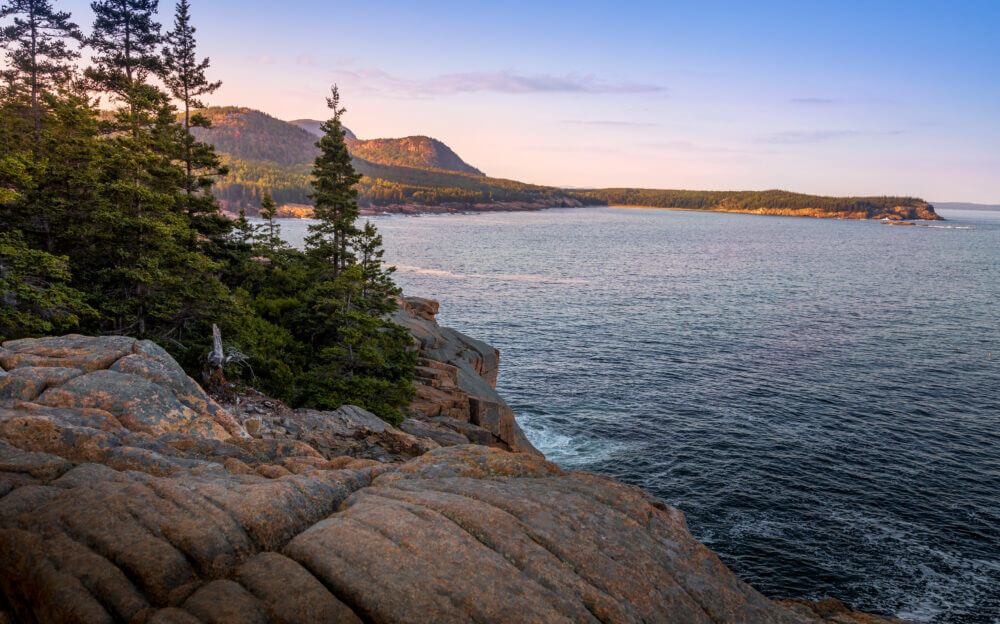
Acadia National Park is most famous for its rugged, breathtaking coastline, but there’s more to explore on its mountaintops, lakes, and ponds. Read our Acadia National Park guide before you go.
2021 is expected to be an exceptionally busy year for National Parks, so minimize your impact by staying off busy trails and following Leave No Trace principles. The most up-to-date source for COVID-related policies and closures, along with conditions within the park is the park’s website.
There’s really nothing else like it. It’s the jewel of the North Atlantic coast: a rare meeting of ocean and mountains, with evergreen forests fanning out from craggy granite peaks onto miles of rugged coastline. A visit to Maine’s Acadia National Park takes adventurers through one of the most varied landscapes the National Park system has to offer, and the word is out.
There are 3.5 million visits made to the park annually—making it one of the most popular national parks—but it’s also one of the smallest with 49,052 acres of protected land. Compare that with Grand Teton National Park, which received roughly the same number of visitors in 2019 but is 310,000 acres—more than six Acadias.
From June to August it gets crowded but don’t let that keep you away. Acadia is worth a visit any time of year, but it just takes some insider info to avoid the crowds during peak season. This Acadia National Park guide will help you get the most out of your visit to the park, combining my own experience with tips and recommendations from longtime AMC trip leader Sue Alperin and AMC’s multi-sport guidebook Outdoor Adventures: Acadia National Park by Jerry and Marcy Monkman.
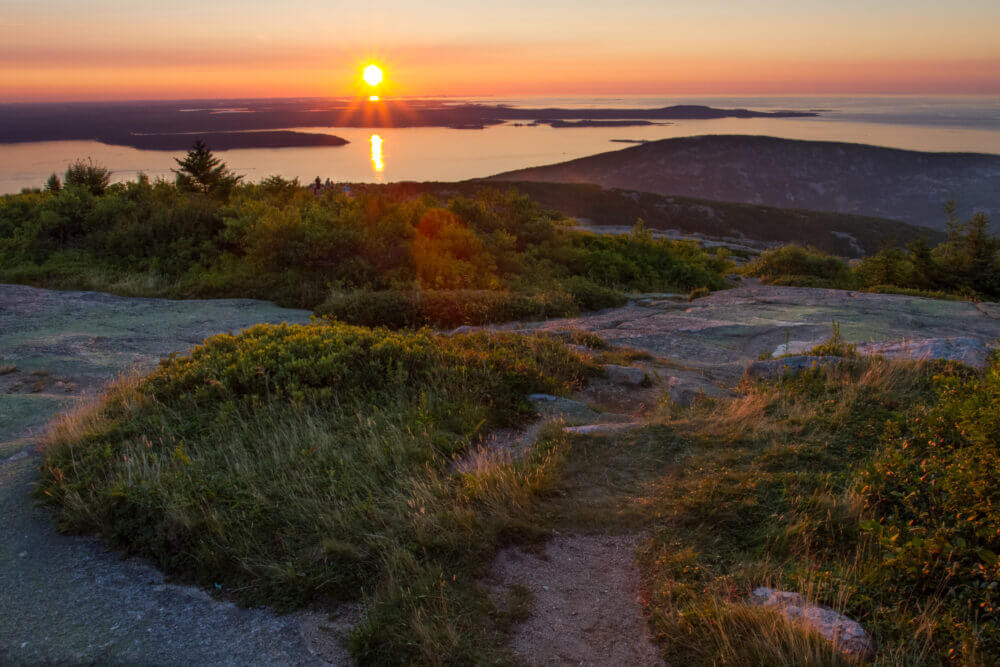
Craggy summits, a rugged coastline, an incredible recreation infrastructure. Acadia is like nowhere else.
Meet Acadia
Almost all of Acadia National Park sits on Mount Desert Island (MDI) and skirts the edges of island communities Bar Harbor, Southwest Harbor, Northeast Harbor, and Mount Desert. The park’s protected lands also extend onto Schoodic Peninsula across Frenchman Bay to the east and several outer islands to the south, including Isle au Haut and the Cranberry Islands.
The MDI portion of the park is divided in two: the east side and west side. The eastern side is nestled between Somes Sound to the west and Frenchman Bay to the east. All the most popular attractions are concentrated there, so it is by far the busiest part of the park. Twenty-seven-mile Park Loop Road is the main drag. It’s a 3 to 4 hour drive that winds along the coastline, delivering near constant knockout ocean views and passing almost all the tourist hotspots.
The main attractions on the east side are the extensive carriage road system, the island’s highest peak (Cadillac Mountain), and only two sandy beaches (oceanfront Sand Beach and Echo Lake Beach), along with the most popular hiking trails and first-rate popovers at Jordan Pond House. It’s the most visited part of the park for a reason, but it’s not the only way to experience Acadia.
The west side of the park is known as “the quiet side” since it receives significantly fewer visitors. There are no carriage roads so bikers will be less spoiled; aside from that, it’s nearly identical to the east side. The hiking trails pass through the same lush forest onto open ridgelines and rugged peaks, but the lower foot traffic makes them feel more untamed. The coastline is a hair less spectacular, but it more than makes up for it when you have the whole view to yourself.
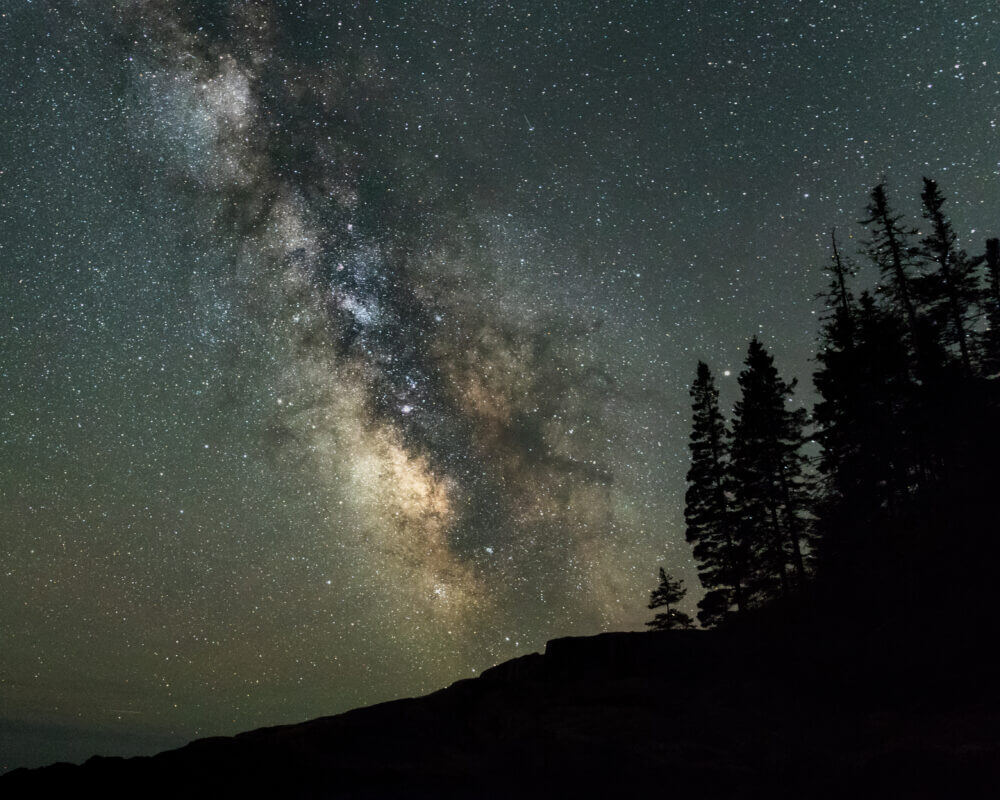
The lack of light pollution in the park makes for incredible stargazing, especially in the summer when the Milky Way is at its brightest.
When to Visit
Acadia experiences all four seasons and is worth a visit any time of year. AMC’s Alperin moved to the region several years ago. “I worried that living here would make it less magical, but it hasn’t,” she says. The landscape is astonishingly dynamic as it’s colors and mood shift with the passing seasons and recreation opportunities never run out. Here are some tips to get the most out of your trip whenever you visit.
Spring: If you’re packing for a spring trip, you’ll need to prepare for just about anything. Temperatures range from the 30s to the 70s Fahrenheit. It may be warm and sunny one day then spitting snow and ice the next. It’s also windy and depending on the weather, muddy.
There is a sweet spot in mid- to late-April, when Park Loop Road reopens but the crowds have yet to arrive. That’s my favorite time to be in the park. Just keep in mind that the surrounding towns don’t fully reopen until Memorial Day weekend so lodging and food options will still be limited.
Summer: Be prepared for traffic during Acadia’s busiest season, particularly on holiday weekends when Park Loop Road is mired in gridlock and parking is scarce. If you’re driving, make sure you have a full tank of gas since there are no service stations in the park itself. You can buy your park entrance pass in advance to beat the crowds at the entrance.
To hit popular trails and landmarks but avoid the crowds, arrive before 8 a.m. or after 5 p.m. Take a spin down Park Loop Road first thing in the morning to see scenic Otter Point, Sand Beach, and Thunder Hole, a natural inlet that sees big wave action. Then spend the day hiking, paddling, or biking. The lunch rush at Jordan Pond House is as famous as its popovers, so go later the day.
The coastal climate usually keeps temperatures pretty mild, but they can range between 45 degrees Fahrenheit at night and as high as 90 degrees on the hottest days. Be sure to pack appropriately. There’s also more fog, mist, and haze than other times of the year.
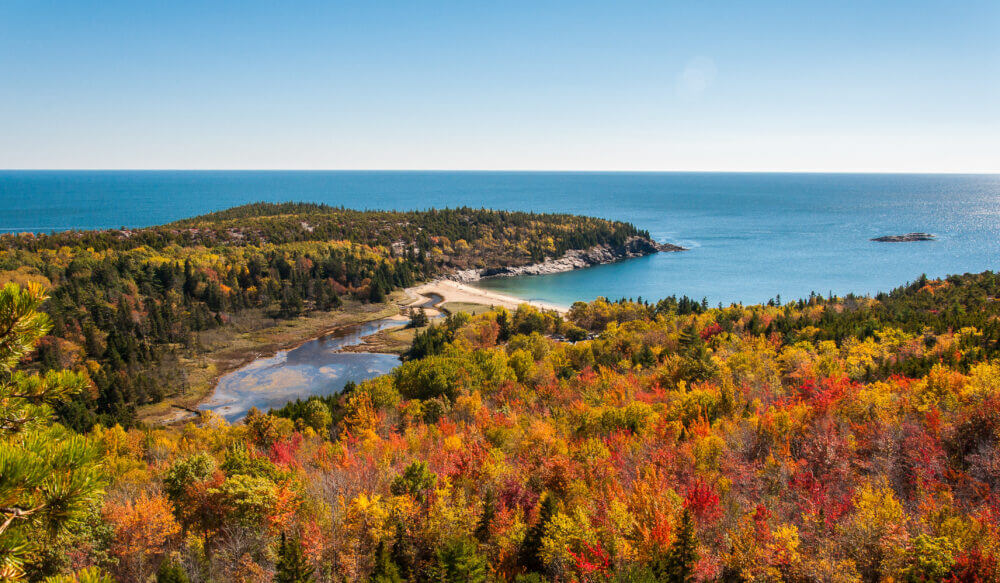
Fall is one of the most popular and beautiful times of year to visit Acadia.
Fall: It’s less crowded. It’s less hot. There are fewer bugs. It’s just about as perfect as perfect gets. The air is crystal clear, so at night you’ll find some of the best stargazing in the east and during the day every vista stretches even further. On the clearest days you can see Mount Katahdin, the northern terminus of the Appalachian Trail, from the summit of Cadillac Mountain.
By mid-October the fall foliage peaks and becomes the star of the show. Then, heavily forested trails reveal stunning views as the leaves drop. Coasting above the drama of the changing leaves are millions of songbirds and raptors following migration routes from Canada further south to the Caribbean and Central and South America. Acadia becomes a birder’s paradise.
The peaks on the east side stay fairly busy but the western mountains have sweeping views of the foliage too. You can also hit the water to see the colors by kayak on one of the park’s ponds or take a boat cruise off the coast. Keep tabs on the foliage with Maine’s fall foliage tracker.
Winter: Once the leaves drop, Acadia gets quiet. Many of the hotels, restaurants, and shops in the surrounding towns close for the season. Even most of Park Loop Road closes on December 1 and only reopens on April 15 if weather permits. However, that doesn’t mean the fun stops.
As soon as there’s enough snow, cross-country skiers and snowshoers take to the carriage roads. You can even ski or snowshoe on the sections of Park Loop Road closed to cars—just watch out for snowmobiles! The night skies aren’t quite as clear as in fall, but it’s possible to see the northern lights. Check NOAA’s aurora forecaster to see if it’s a good night to try your luck.
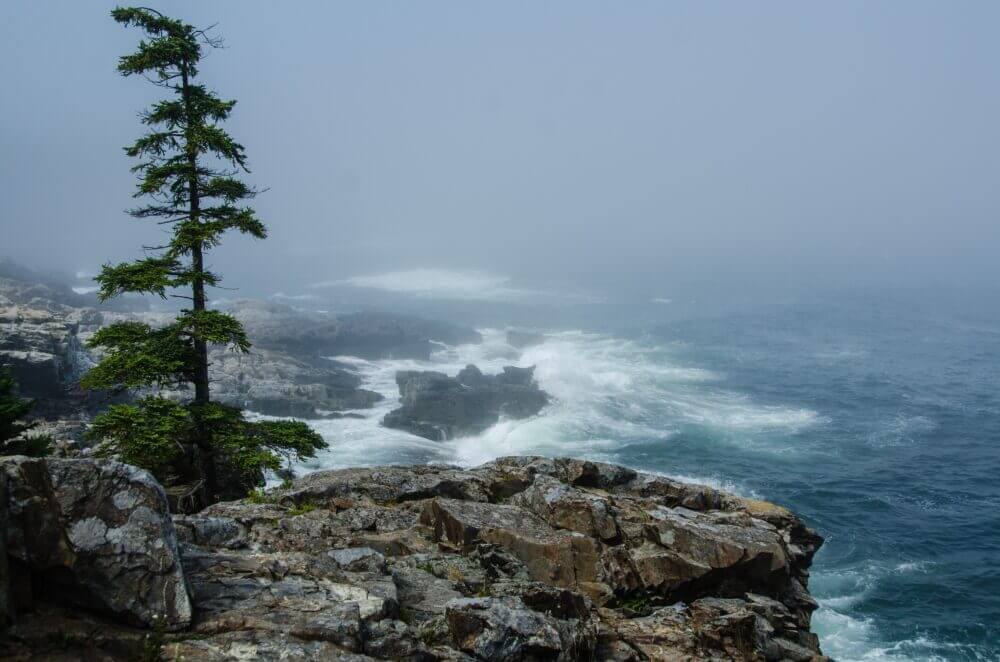
When visiting Acadia, always be prepared for a rain shower or a windy day.
What to Bring
The temperatures can vary widely at any time of year, so pack plenty of layers. If you’re hiking a peak, stash one or two in your pack since the higher elevations are often colder and windier than sea level. The Maine coast is also ranked second to the Pacific Northwest in annual precipitation, so pack a rain jacket.
If you’re planning on adventuring, pack the Ten Essentials, including a map and compass that you know how to use. Cell service is limited, so don’t rely on your phone for navigation. Also, be sure to check the park’s website for the most up-to-date safety information.
Getting There
Most people who visit Acadia drive. It’s the best way to get to Mount Desert Island, but there are more options once you get there. The most common routes are from the south, using I-95 north to Bangor and then either Routes 3 or 1A east through Ellsworth to MDI.
If you’re new to coastal Maine and plan to drive in from the south, I’d recommend driving at least a portion of scenic Route 1. It’s prone to gridlock during the summer and when the foliage peaks in the fall, so either get an early start or drive it in the off-season.
Most visitors from farther away fly into Boston and drive from there, but you can fly into Bangor International or Portland International Jetway, which is served by more airlines than Bangor.
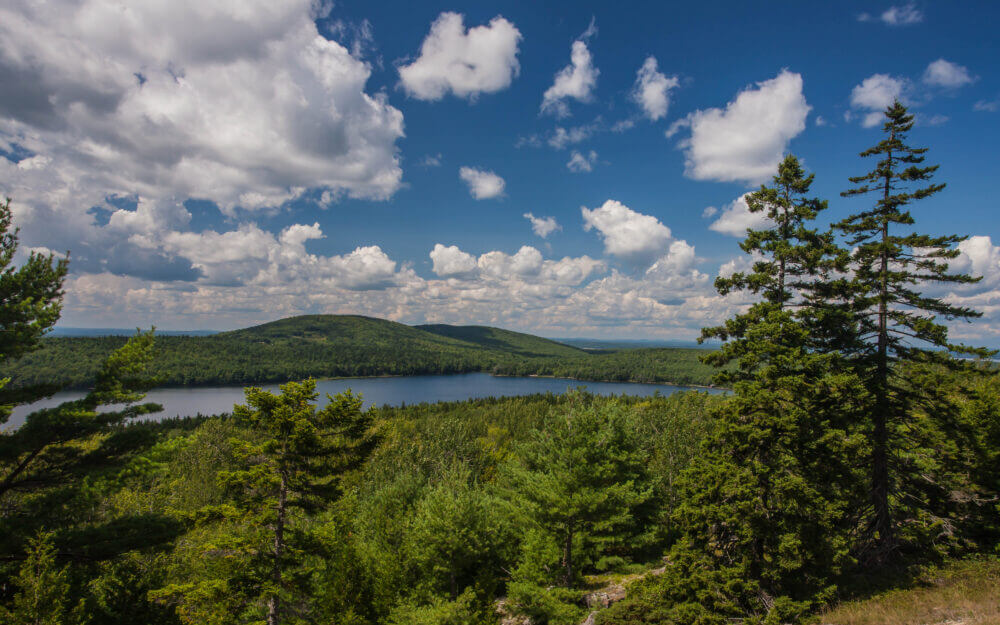
Park Loop Road is the most popular way to see the park and it’s no wonder why! It has dozens of stunning viewpoints like this one of Eagle Lake.
Getting Around
You don’t need a car to have a great visit. The free Island Explorer bus system links hotels, inns, and campgrounds with destinations within the park. It’s a great option to avoid traffic and parking headaches during the busy season. You can also bring your bike or rent one in town and bike into the park.
The Island Explorer bus system will be running with limited routes and capacity for the 2021 season, but it will still traverse most of the park. Check the system’s website for the most up-to-date routes and information.
Where to Stay
With so many towns nearby there are lots of options for accommodations, including hotels, inns, and vacation rentals. If you plan to camp, there are four campgrounds in the park with varying amenities and twelve private ones elsewhere on the island. You can book your reservation in advance. Backcountry camping is not permitted in Acadia. Buy your firewood locally to avoid introducing non-native pests to the island.
One of these private campgrounds is AMC’s Echo Lake Camp. The camp is on the island’s west side and has platform tents with canvas sides that are equipped with cots, blankets, mattresses, and pillows for two to five people. There’s also a full-service dining hall providing three meals a day, a library, a recreation hall, flush toilet, and shared bathhouse with hot showers.
Cost of Admission
A park entrance pass is required for all visitors, and if you’re driving, keep it visible through your windshield. You can buy your pass in advance or in-person at the park. The current fee is $30 per vehicle, and the pass is valid for seven days. Discounted passes are available for motorcyclists and people who enter the park without a vehicle, including cyclists and hikers.
Annual passes are available for $55. You can also purchase an annual America the Beautiful pass for $80 that provides you access to more than 2,000 federal recreation sites.
What to Do
Before you start your adventure, familiarize yourself with Leave No Trace principles to minimize your own impact on the park. Also, keep in mind that unlike many other national parks there aren’t always hard boundaries between the park and private property. When it comes to Mount Desert Island’s local communities, be patient and respectful.
If you’re new to the park, one of the visitor centers is the best place to begin. You can purchase hiking essentials such as maps and guidebooks, and even souvenirs. While you’re there, ask a ranger for personalized recommendations for adventures and see what programs are coming up.
The visitor centers operate seasonally so check their operating hours and dates.
If you’re visiting with kids, they can become a Junior Ranger by completing an activity booklet available at the visitor center and attending ranger-led programs. Another kid-friendly spot is the Sieur de Monts area on the east side. It has a nature center with hands-on exhibits, gardens, and the Abbe Museum which is dedicated to the history and culture of Maine’s Indigenous population.
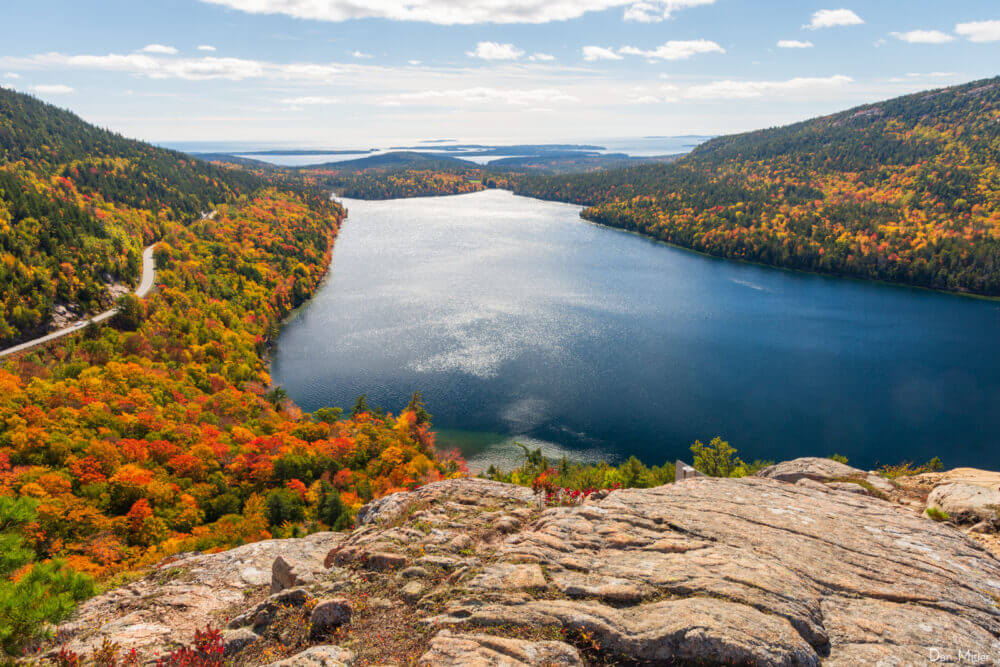
Acadia’s many ponds, including Jordan Pond pictured here, make for stunning scenery whether you’re on the water or above it.
Eastern Mount Desert Island
Hiking: The most popular hiking trails in Acadia are here. Ocean Path is an easy stroll that runs parallel to Park Loop Road along a particularly stunning stretch of coastline with jagged pink granite formations between Sand Beach and Otter Point. Peak baggers and sunrise chasers can climb up—or drive up with a reservation—Cadillac Mountain (1,530 ft.), the highest point on the North Atlantic seaboard and the first place in the United States to see the sunrise at certain times of the year. Experienced thrill seekers can traverse sheer cliff faces and narrow ledges using ladders and steels rungs on Precipice Trail and Beehive, taking in breathtaking ocean views along the way.
Bar Island Trail is another popular hike, but Sue Alperin recommends saving it for the winter months. The trail follows a narrow gravel bar that appears in the Mount Desert Narrows for half an hour on either side of low tide and links the town of Bar Harbor to Bar Island. Alperin explains why it’s worth hiking during the winter months: “There’s steam that comes off the rocks when it’s really cold. It’s like walking through a sea of fog.” Just be sure to wear your crampons since the rocks can be slippery and check the tide chart before you head out.
If you’re looking to escape the crowds during peak season or just get off the beaten path, there are plenty of other trails to explore. Hunter’s Beach Trail is an easy, family-friendly hike to an isolated cove with a cobblestone beach. Compass Harbor Trail is another leisurely hike through dense forest the leads to an abandoned estate and a granite outcrop with incredible views. Day Mountain Trail is a moderate climb to the summit of Day Mountain—you’ll know you’ve reached the top when you see the panoramic ocean view. The Bald Peak, Parkman Mountain, Gilmore Mountain, and Sargent Mountain Loop is a relatively short but seriously intense peak bag with view after view that traverses steep wooded slopes, two small gorges and granite paths above tree line. Click here for a more detailed guide to these routes.
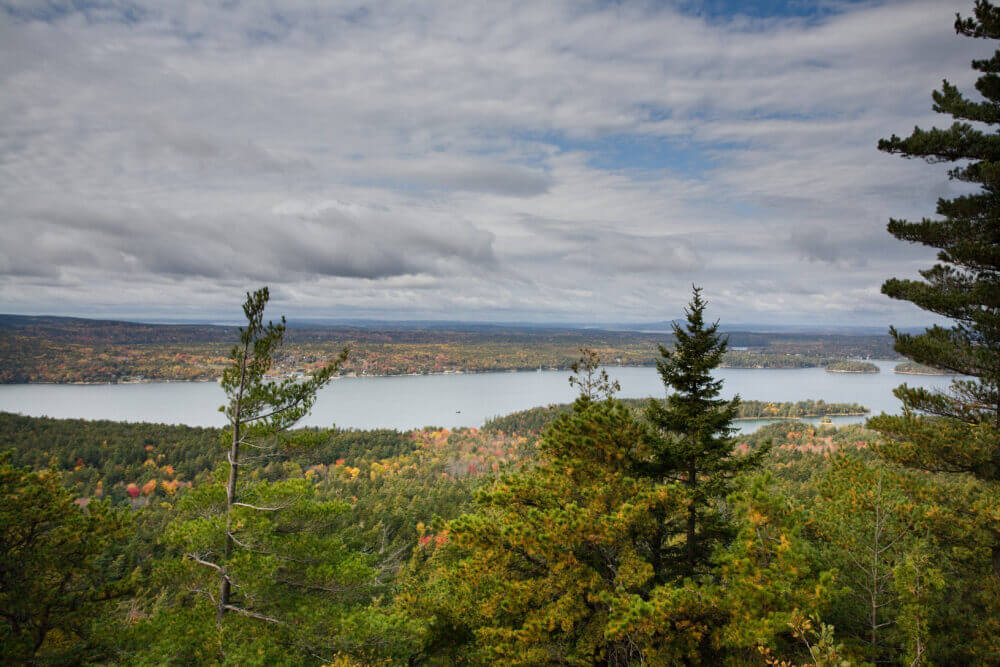
The view from the carriage road that leads to the summit of Parkman Mountain.
Biking: Take your pick of great bike options aplenty on this side of the park, which hosts carriage roads and designated bike paths, along with gravel and paved roads. There are options for every experience level, and if you don’t have your own bike, you can rent one in town. While you won’t find any serious mountain biking in Acadia, there are a few grueling rides that will test the strength and endurance of experienced cyclists.
The 45-mile network of carriage roads that weave around the east side’s mountains and valleys are a biker’s paradise. They host a magnificent system of picturesque bridges, along with mountain vistas and waterfalls. All of the carriage roads are connected, with clear signage at intersections, so there are dozens of possibilities for loop rides of all lengths.
Cyclists do share the roads with horses and pedestrians and are required to yield to other traffic. Only Class-1 e-bikes are allowed. In the spring the carriage roads often close due to muddy conditions. Respect all posted signs and notices and stay updated on temporary closures.
The busiest carriage roads are in the eastern portion of the system, including Jordan Pond Loop and Eagle Lake Loop. Eagle Lake Loop is an easy to moderate ride through the forest along the perimeter of Eagle Lake. Jordan Pond Loop is a moderate 9-mile loop that passes beautiful but busy Jordan Pond, along with the quieter Bubble Pond which has dramatic scenery of its own. In the southeastern corner of the system, a carriage road climbs Day Mountain to reveal sweeping oceans views.
To the west, Around the Mountain Loop is a challenging 12 mile ride that skirts the contours of six peaks, passing three waterfalls and crossing seven carriage road bridges. Amphitheatre Loop passes through a narrow valley between Penobscot Mountain and Cedar Swamp Mountain with the occasional ocean views.
You can also bike into the park and even on Park Loop Road but use caution. Even the most experienced cyclists might find the experience harrowing during the congested peak season. There’s no shoulder on the road and you’ll need to bike with the flow of traffic on one-way sections. Consider familiarizing yourself with the road in advance.
In 2021, access to the historic Eagle Lake Carriage Road will be reduced due to ongoing preservation projects. Severe storm damage has also restricted access to many carriage roads. Check the park’s website for the most up-to-date information.
Quietwater Paddling: Heading out onto Acadia’s quiet inland waters can give you a fresh perspective on this remarkable landscape. A canoe or a kayak is a great vantage point for bird and wildlife watching. Keep an eye out for loons, ducks, bald eagles, osprey and even otters.
Jordan Pond and Eagle Lake are the two biggest bodies of water on the east side. Jordan Pond is the deepest of Acadia’s ponds and lakes. It was scraped out by a receding glacier that also gave the Bubbles at the north end of the pond their distinctive rounded appearance. From the water you can also take in Jordan Cliffs on the east face of Penobscot Mountain. Eagle Lake is the largest lake on this side and has an exceptionally wild shoreline. It has breathtaking views of Cadillac and Pemetic Mountain and the Bubbles.
There’s Even More to Do: Acadia isn’t just about hiking, biking and paddling. In the winter, the all-volunteer Acadia Winter Trails Association grooms more than 30 miles of the carriage roads for cross-country skiing. You can even ski on the spectacular, unplowed stretch of Park Loop Road on Ocean Drive between Schooner Head and Otter Cliff Roads.
The park also has the largest expanse of dark sky east of the Mississippi. The ranger-led program Stars Over Sand Beach is a great way to learn about the night sky. Cadillac Mountain is another great spot to see the stars that’s accessible by car, though there is some light pollution from Bar Harbor.
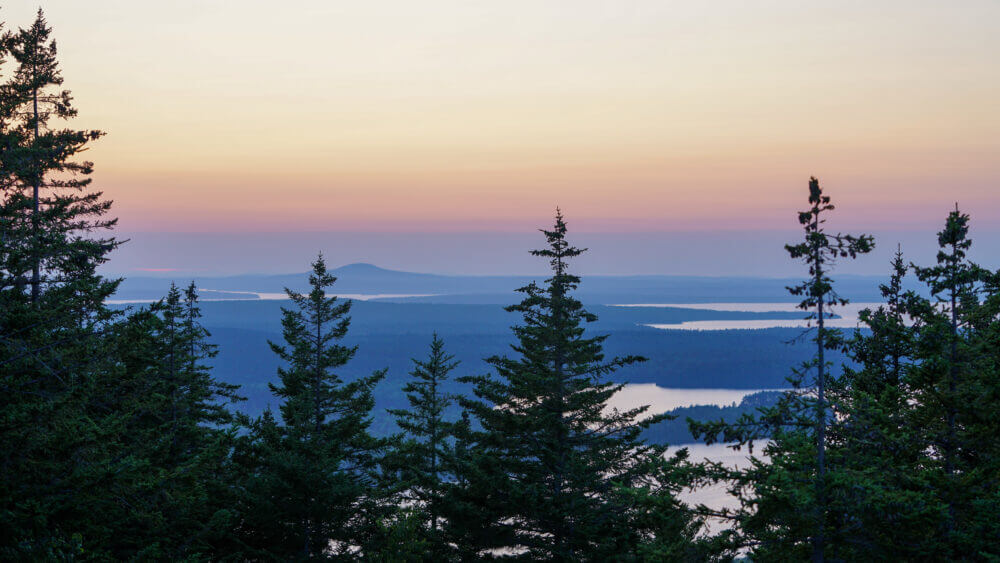
The west side of Acadia is quieter, wilder and every bit as stunning as the busier east side.
Western Mount Desert Island
Hiking: Like the park’s east side, hiking on the west side ranges from flat and easy walks to challenging summit ascents. Sue Alperin recommends Wonderland Trail off Rte. 102 A for an easy stroll to gorgeous beach. “It is wonderous,” she says. “I don’t know how many times I’ve been there but it’s breathtaking.” Summit chasers can hike up Acadia Mountain, one of the island’s tallest peaks, or Flying Mountain, a short peak with great views.
This side of the island also has its fair share of hidden gems, including the Valley Trail/Beech South Ridge Trail route of up a Beech Mountain. It’s an especially scenic way to the summit of this popular peak through a valley Sue Alperin compares to an “enchanted forest.” A trip across forested St. Sauveur Mountain to Valley Peak rewards hikers with a breathtaking view of Somes Sound and Northeast Harbor. Experienced hikers looking for a challenge will enjoy taking Perpendicular Trail to the summit of Mansell Mountain, a route that includes 300 stone steps, iron rungs and a small ladder. Find a more detailed guide to these routes here.
Biking: This side of the island is best explored on dirt fire roads ensconced in a quiet boreal forest. Hio Fire Road near Sewall Campground is a short, easy ride that traverses a spruce forest near Big Heath bog. It’s great ride for birdwatchers since the woods are home to several bird species more common in Canada than Maine. Thickly forested Long Pond Fire Road takes you past a beaver pond and moose habitat to a quiet cove on the park’s Southern Neck peninsula. There are an additional ten miles of fire roads around the western mountains. Views are scarce but they feel wild, more like the North Maine Woods than a coastal National Park!
Quiet Water Paddling: This main paddling destinations on this side of the island are Long Pond, Echo Lake, and Seal Cove Pond. The southern end of Long Pond is tucked between the dramatic cliffs of Beech and Mansell Mountain. It’s quieter than the north end since it sees less motorboat traffic. The north end is still worth exploring for its views of the surrounding mountains and secluded coves. Alperin recommends a fall visit since it’s one of the less crowded spots to take in the fall foliage from the water. Echo Lake is home to AMC’s Echo Lake Camp and is also a great place to swim since it has a sandy beach. A paddle on the lake also offers the chance to take in the best view of Beech Mountain’s cliffs. Seal Cove Pond has less dramatic scenery but it’s great for birdwatching since a wide range of waterfowl frequent its shallow waters. You may even spot a bald eagle.
There’s More to Do: While you’re on the west side Alperin also recommends a visit to Seawall, about 2 miles northeast of Wonderland off Rte. 102A. It’s named for the naturally occurring seawall there created by the massive storms that pummel the exposed coastline. The park service hosts programs there, including stargazing and bird watching—the area is a great spot to look for ducks and other sea birds! Since it’s on the busier side, Alperin recommends a visit at dusk or dawn to watch the colors in the sky, and on the water, change.
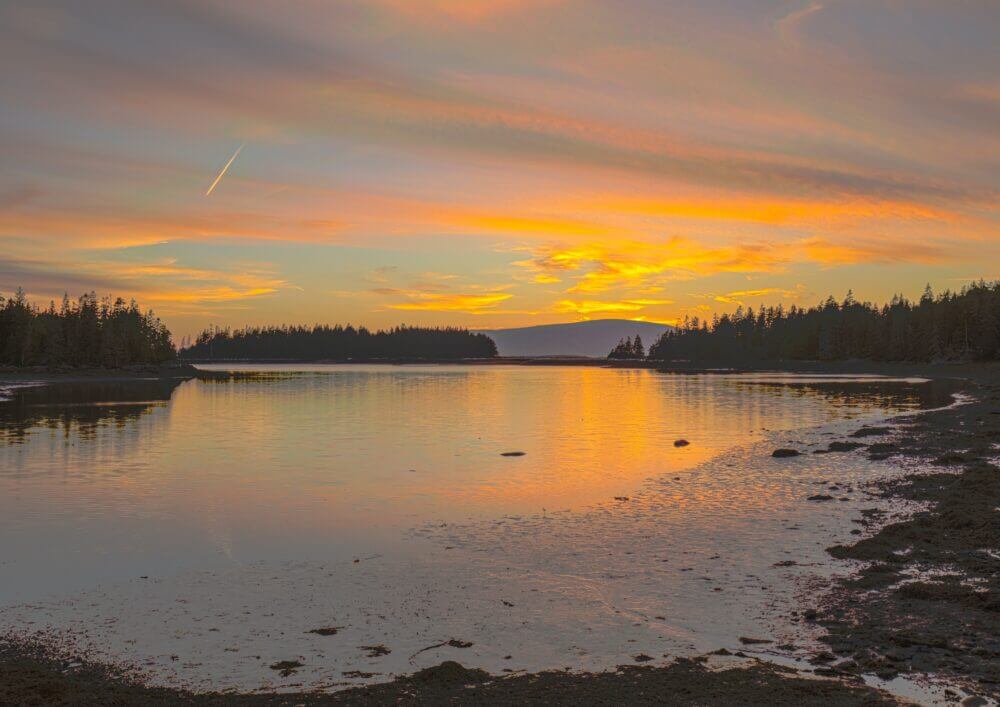
The views along Schoodic Loop Road can be every bit as dramatic as those on Park Loop Road in Eastern MDI.
Adventures Beyond Mount Desert Island
Don’t forget that Acadia isn’t just Mount Desert Island! There are adventures to be on Schoodic peninsula to the east, offshore on Isle au Haut and even on the ocean.
Schoodic Peninsula
Schoodic Peninsula sits just across Frenchman Bay from Mount Desert Island. Just 10 percent of the park’s visitors make it here for a more laid-back experience of Acadia. The coastline is still high on natural drama, and there’s less traffic on the roads and on the more gentle, meandering trails. Downeast magazine has asked, “Might sparsely visited Schoodic secretly be Acadia’s coolest corner?”
6-mile long Schoodic Loop Road traverses the outer of edge of this thickly forested headland, where the waves crash into the pink granite ledges with enormous force. Unlike Mount Desert Island there are no islands or reefs off Schoodic to put the brakes on the ocean so the geysers of sea spray rival MDI’s Thunder Hole. For the most part, the seaside ledges are level with road so there are lots of spots to pull off for a picnic, birdwatch or just take in the view. It’s also a great spot for stargazing since it’s so isolated.
The highlight of this scrappy bit of coastline is Schoodic Point. It can be accessed down Arey Cove Road off the southwest side of Schoodic Loop Road. The crashing waves and massive granite shelves are at their most dramatic here. Take a walk and explore the glaciated rock formations, just be careful. The ledges are slippery and a fall can be fatal. Alperin’s favorite time to visit the point is during winter. “When it’s super cold and the waves are crashing on the rocks, there always tends to be a coating of ice and the ice can freeze in the shape of the wave,” she says. Birdwatchers will also be delighted by the variety of ducks that winter in Acadia and can be found in abundance, bobbing up and down in clusters on the frigid Atlantic.
Getting There: Most visitors drive to Schoodic from Bar Harbor. It’s a 50-mile drive on coastal roads that takes just over an hour. The park’s Island Explorer bus system has a dedicated route to Schoodic, and in the summer you can take the ferry from MDI.
Where to Stay: Schoodic has relatively sparse options for accommodations. There are vacation rentals available, but the Monkmans recommend staying at Schoodic Woods Campground. It has some neat amenities including a 100-seat amphitheater for programs and activities, and a fireplace nook in the visitor center. It’s also the main hub for the island’s trail system which is also accessible from various points on Schoodic Loop Road.
Biking: If you have a bike, bring it. Don’t have one? You can rent one in Bar Harbor or Winter Harbor. Schoodic has 8 miles of carriage road-style bike paths that traverse the peninsula’s hilly, forested interior with views of the coast at high points. The network of bike and hiking trails intersect creating dozens of options for mixed hike/bike adventures. The trails near the campground are easy rides but become challenging near Frazier Point and in the northeast section of the trail network.
Hiking: Seven and a half miles of hiking trail crisscross the peninsula, stretching from the town of Winter Harbor to the southern edge of the peninsula at Blueberry Hill. They’re more leisurely than the trails on MDI, setting a relaxing pace. Schoodic Head Loop takes you to best viewpoint in the trail network. It’s a 1.9-mile moderate hike that starts out on grassy Alder Trail at Blueberry Hill before continuing up a dirt road to Schoodic Head Trail. The eastward viewpoint Schoodic Head (440 ft) is at the end of the trail past the intersection with Anvil Trail. Anvil will lead you back to the road where you can walk a short distance west to return to Blueberry Hill.
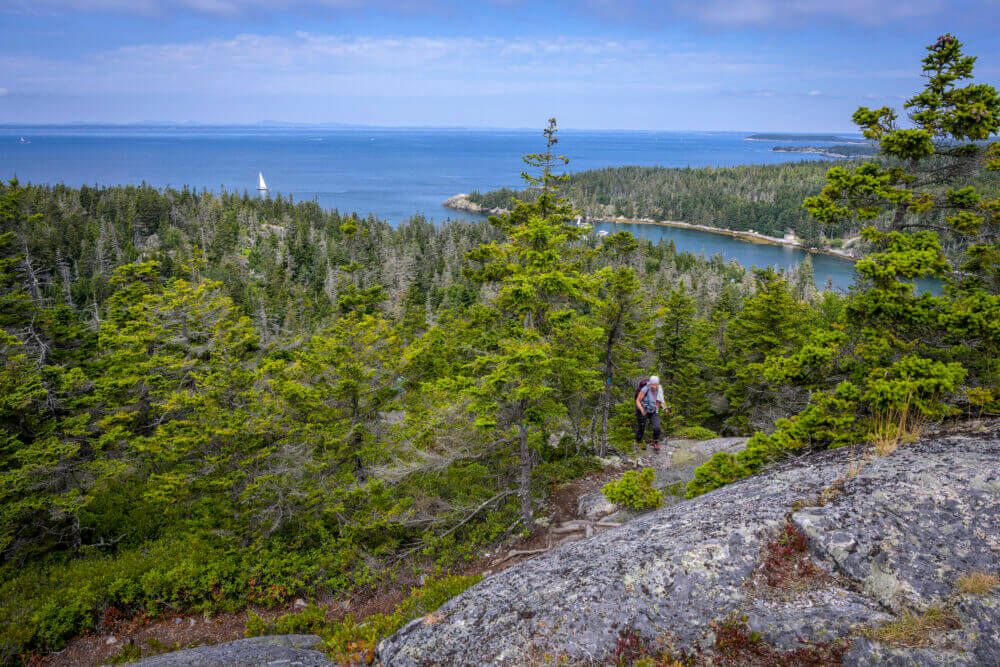
The trail up Duck Harbor Mountain offers the best views on Isle au Haut.
Isle au Haut: “The Other Acadia”
Five miles out to sea and home to fewer than 80 year-round residents, Isle au Haut is the least visited part of the park with only about 10,000 visitors a year. AMC authors Jerry and Marcy Monkman call it “the wildest part of Acadia” because of its rough-hewn oceanside cliffs, deserted beaches, and 18-miles of rugged mixed-use trails. Half of the 8,000-acre island belongs to the lobstering town of Isle au Haut. The town itself has few amenities but does have a general store and a seasonal food truck.
Getting There: Take the passenger-only ferry from Stonington, ME, an hour and a half drive from Bar Harbor. It’s a 45-minute trip past granite trimmed islands and Isle au Haut Light (one of Maine’s youngest lighthouses at a mere 114 years-old). If you’re visiting in summer, disembark at Duck Harbor Landing near the trailheads and campground. Otherwise, the only stop is on the other side of the island in town. Skilled sea kayakers can paddle the 6 miles from Stonington as a day trip or as part of an island-hopping adventure.
Where to Stay: Visiting just for the day is doable but if you want to stay on the island the only accommodations are rental homes and Duck Harbor Campground. The campground has five tent sites with lean-tos, potable water from a hand pump, clean privies, and free firewood. There’s no electricity, limited cell service and you’ll have to pack your trash out. The campground is open May 15 to October 15. Reservations are sought after so book early.
Biking: With very few cars and quiet trails, Isle au Haut is an intriguing destination for cyclists—just be sure to bring a mountain bike! There are five miles of paved roads and seven miles of unpaved roads that intersect with the island’s network of hiking trails so it’s a great “bike and hike” destination for all skill levels. The ferry does charge an additional fee to transport bikes.
Hiking: The 18 miles of trails on the island traverse wooded uplands and marshes, a few small peaks in the island’s interior, and secluded sections of the coastline with coves and cobbled beaches. The astonishingly varied landscape, well-maintained trails, and intense isolation make this a hiking experience like few others in the region.
One of the best ways to take in the coast is Western Head/Cliff Trail Loop. This moderate, 3.7-mile loop starts out at the campground and traverses the southwestern point of the island via Western Head Trail and Cliff Trail before looping back to the road. It skirts a stunning stretch of rocky coastline, dipping down to cross rocky beaches and isolated coves.
For the best summit view, take the strenuous, 2.4-mile out-and-back Duck Harbor Mountain Trail. It starts out on Western Head Road just south of the campground. You’ll pass several impressive viewpoints as you ascend Duck Mountain. Continue over the summit across several additional high points that require some serious scrambling before descending as it nears the ocean. The trail ends at Squeaker Cove.
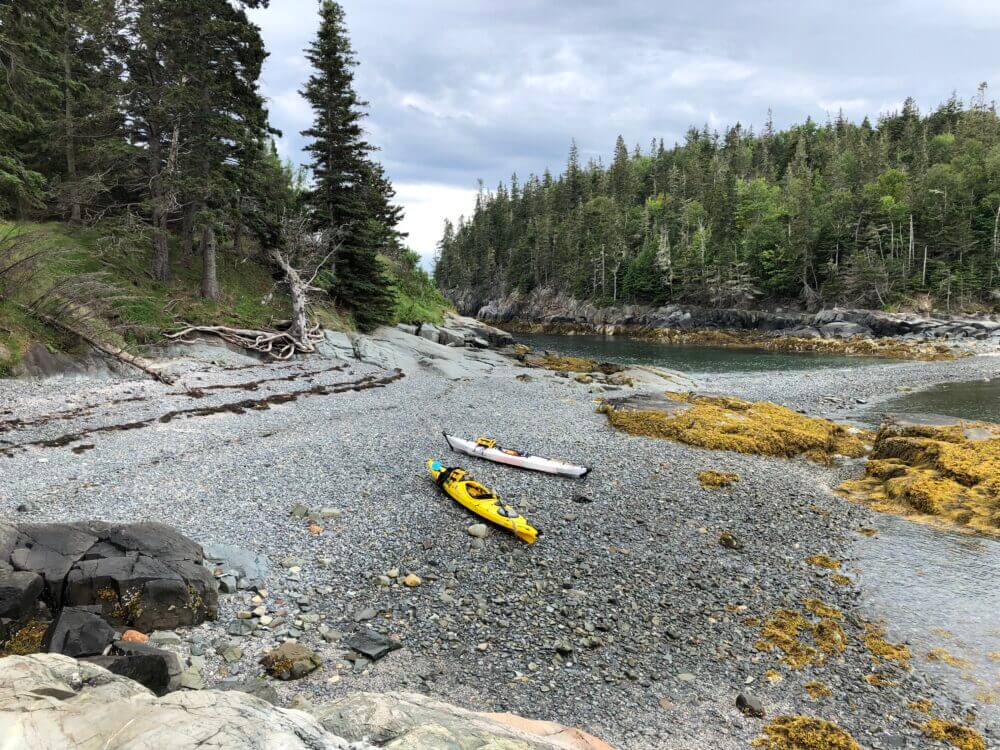
For experienced sea kayakers, there are plenty of islands off the coast of MDI to build your own island hopping adventure. That includes the Porcupine Islands pictured here.
Sea Kayaking
The Monkmans describe the experience of sea kayaking in Acadia best: “[It’s] like no other experience in the park, with dramatic scenery and wildlife sightings practically guaranteed… You also gain a lot more freedom to explore the myriad of inlets and coves that make up the shoreline of Mount Desert Island and the other islands in Frenchman Bay.”
It’s an enticing experience but if you don’t already have experience paddling on the open ocean, start out with a class or a guided paddle with one of the area’s many local outfitters. The water temperatures are cold, the low 50s Fahrenheit at the warmest, and fog is a near constant possibility, so you need to know what you’re doing before you hit the water. Always check the tide and weather forecasts and be mindful of you own condition, in addition to changes in the weather and the waves. The difficulty of every sea kayaking trip depends on the weather conditions.
For a relatively sheltered paddle in shallow waters try the Mount Desert Narrows, the body of water that separates Mount Desert Island from the mainland. The uninhabited islands, mud flats, and salt marshes are haven for wildlife like harbor porpoises, great blue herons, and bald eagles. Since the waters are so shallow, plan your trip during high tide to maximize the area you can explore. Advanced sea kayakers can also explore the islands off MDI, including the Porcupine Islands and the Cranberry Islands. There is heavy boat traffic around the islands so avoid heading there when it’s foggy. You can also stop by the islands themselves to get out and explore. You can also paddle in Somes Sound and Frenchman Bay.
To learn more about sea kayaking opportunities speak to a local outfitter and consult guidebooks, such as the Monkmans’ Outdoor Adventures: Acadia National Park and AMC’s Best Sea Kayaking in New England by Michael Daugherty.
As always, trails and accommodations can change without notice, so be sure to double check specific routes or plans with park staff. Now, what are you waiting for? Go plan your Acadia getaway!